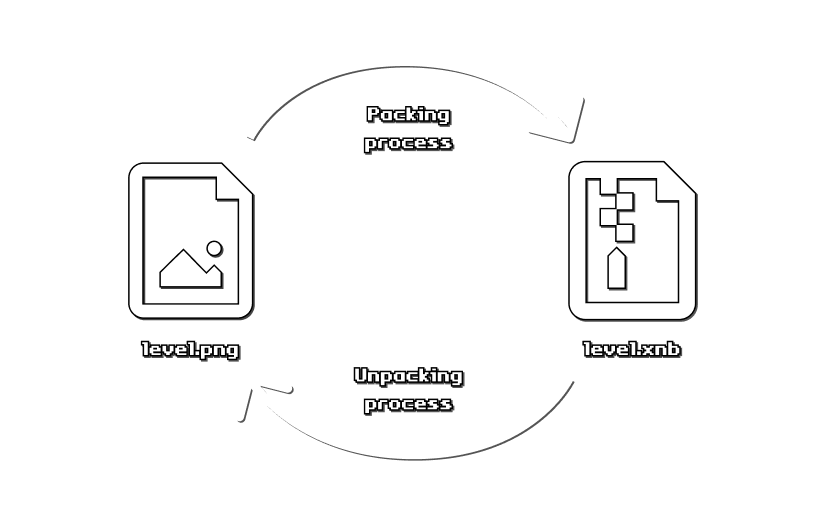File types
distinguishing and understanding the file types and format.
Table of contents
Configuration files
All configuration files in Jump King use the XML format.
XML and mark-up language
XML (which stands for eXtensible Markup Language) is a type of markup language that is used to store and exchange data in a structured format and is widely used as a standard for exchanging data between different applications and platforms.
A markup language is a set of rules for adding tags (also known as “markup”) to a document to define its structure and meaning. In XML, you use tags to define the structure of your data.
XML rules
A tag name:
- cannot contain special characters and/or spaces.
<!-- ❌ NOT VALID --> <volume audio 🎵></<audio name 🎵> <!-- ☑️ VALID --> <volume_audio></volume_audio> - can contain a value:
<!-- ☑️ VALID --> <audio_enabled>true</audio_enabled> <speech>Lorem ipsum dolor sit amet, consectetur adipiscing elit. Pellentesque in pulvinar nisi. Interdum et malesuada fames ac ante ipsum primis in faucibus. Etiam nec lectus quis mi vehicula tristique. Vestibulum finibus libero ac varius consectetur.</speech> <sprite>Character</sprite> <sprite>☑️</sprite> <screen>12</screen> <audio_volume>0.12</audio_volume> - can contain other tags:
<!-- ☑️ VALID --> <merchant> <trading>Silver</trading> <npc_settings> <position> <X>128.5</X> <Y>62</Y> </position> <screen>3</screen> </npc_settings> </merchant> - is case sensitive:
<!-- ⚠️ X and x are two different tags! --> <X>64</X> <x>63.5</x> - must be properly nested and closed:
<!-- ❌ NOT VALID --> <first><second><third>1.5</second></third></first> <first><second><third>1.5</second></first> <!-- ☑️ VALID --> <first><second><third>1.5</third></second></first>
Practical example
For instance, if you were creating an XML document to store information about the locations in Jump King, you might use tags to indicate the start and end screen, title animation trigger screen (unlock) and name. Here’s an example of what a portion of the XML document might look like:
<locations>
<Location>
<start>1</start>
<end>8</end>
<unlock>2</unlock>
<name>Jungle</name>
</Location>
<Location>
<start>9</start>
<end>15</end>
<unlock>9</unlock>
<name>Keep of Despair</name>
</Location>
</locations>
In this example, the locations element contains two Location elements, each of which has child elements for the start and end screen, title animation trigger screen (unlock) and name.
While the previous XML example is grammatically valid, this will not work since the snippet is not complete to work in-game. Check out Locations to implement properly.
The tags define the structure of the data, making it easier to parse and process by computers.
Packed files
All images, sounds and fonts are stored as packed XNB files.
These files are packed into XNB format to make them more efficient and faster to load when running Jump King.

Why are packed files necessary?
To understand why this is necessary, let’s consider an example of an image file. When you save an image file on your computer, it typically includes a lot of additional data such as the date created, the author, the file format, and so on. This data (called metadata) takes up space and slows down the loading of the file especially.
Similarly, when a game loads content such as images or sounds, it needs to read all of this metadata along with the actual content, which can slow down the loading time.
By packing the content into XNB files, MonoGame (the game engine) can strip out the unnecessary metadata and compress the content to make it smaller and faster to load. This results in a more efficient content management and strips additional time loss.